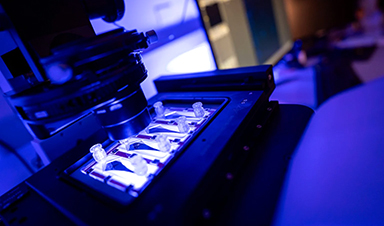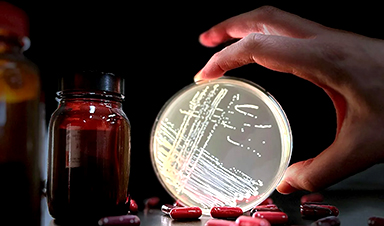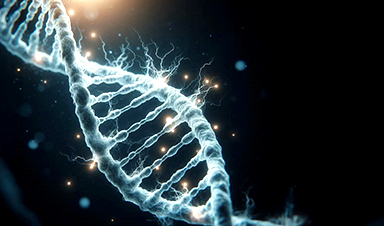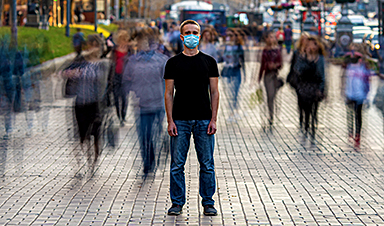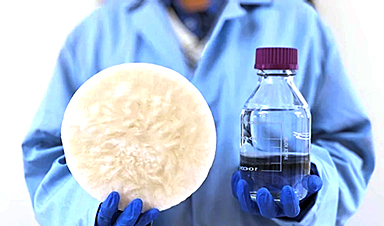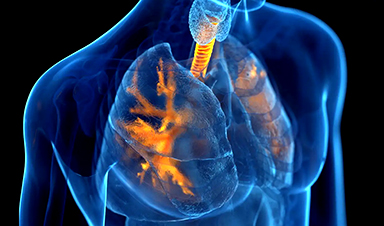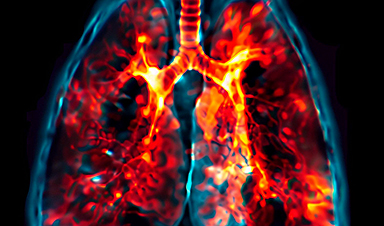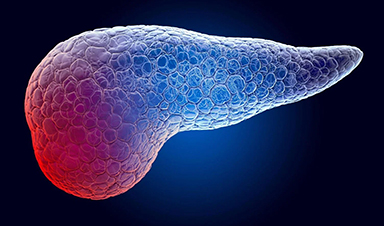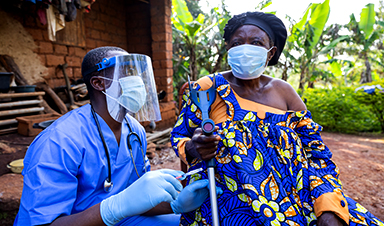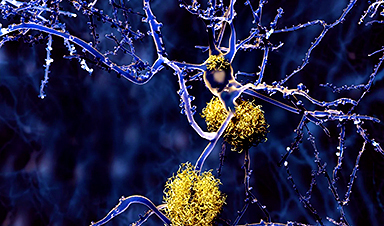Cedars-Sinai Cancer investigators have developed a new nanotechnology-based test that can detect and profile prostate cancers—even in microscopic amounts. Their work, published in the journal Nano Today, suggests that this “liquid biopsy” test could spare many patients unnecessary treatment-related side effects, directing them instead to effective therapies that could prolong their lives.
Cancer of the prostate, a walnut-sized gland just below the bladder, is the most common cancer and second-leading cause of cancer death among U.S. men.
The test developed by Posadas and co-investigators isolates and characterizes extracellular vesicles, also called EVs, from blood samples. EVs are microscopic packets of protein and genetic material that are shed by cells. The EV Digital Scoring Assay can pull these EV packets from the blood with unprecedented efficiency and analyze them in a manner that is faster than any currently available test.
The investigators tested blood samples from 40 patients with prostate cancer and found that the test was able to distinguish cancer localized to the prostate from cancer that had spread to other parts of the body.
Posadas envisions this test being used to help patients who have their prostate gland removed and later experience a rise in levels of prostate-specific antigen (PSA) in their blood. This happens in about 30% of post-surgical patients, and elevated PSA levels can indicate cancer recurrence.
If a remnant of the cancer has been left behind in the prostate bed, where the prostate gland once was, Posadas said focused radiation therapy can cure the disease or delay progression. But that treatment is not without risks.
“The bladder and rectum are near the prostate bed and can be damaged during the course of radiation therapy,” Posadas said. “The risk is only worth it if a man is going to benefit.”
If microscopic cancer deposits have spread outside the prostate area, focused radiation treatment will not prevent disease progression. These deposits, called micro-metastases, are not always detectable, even via the most advanced imaging, but investigators were able to detect them using the EV test.
“This would allow many patients to avoid the potential harms of radiation that isn’t targeting their disease, and instead receive systemic therapy that could slow disease progression,” Posadas said.
In retrospective case studies, investigators tested blood samples taken over time from three prostate cancer patients, including one patient who had undergone focused radiation treatments.
“At the time he was being treated, I was concerned that he was not benefiting,” Posadas said. “And the test results mirrored his clinical behavior and showed that, indeed, the treatments were not effective because he had micro-metastatic disease.”
The test is the latest in a yearslong series of Cedars-Sinai Cancer breakthroughs involving EVs. Posadas said that it could also be adapted to guide treatment as prostate cancer therapies become more targeted at the molecular level, ultimately extending patients’ lives. Posadas and his team of investigators are now working to further refine the test so that it can be studied in greater detail.
“This type of liquid biopsy, coupled with innovations such as our Molecular Twin initiative, is key to next-generation precision medicine that represents the newest frontier in cancer treatment,” said Dan Theodorescu, MD, Ph.D., director of Cedars-Sinai Cancer and the PHASE ONE Distinguished Chair.
“And the type of progress we are making is only possible at an institution such as Cedars-Sinai Cancer, where we have patients, clinicians, scientists and creative engineering minds converging as one unit to address the most challenging problems in cancer.”
Posadas and the team aim to work with local and national partners and hope to see the test come into wide clinical practice in the near future.
News
Baffling Scientists for Centuries: New Study Unravels Mystery of Static Electricity
ISTA physicists demonstrate that contact electrification depends on the contact history of materials. For centuries, static electricity has intrigued and perplexed scientists. Now, researchers from the Waitukaitis group at the Institute of Science and [...]
Tumor “Stickiness” – Scientists Develop Potential New Way To Predict Cancer’s Spread
UC San Diego researchers have developed a device that predicts breast cancer aggressiveness by measuring tumor cell adhesion. Weakly adherent cells indicate a higher risk of metastasis, especially in early-stage DCIS. This innovation could [...]
Scientists Just Watched Atoms Move for the First Time Using AI
Scientists have developed a groundbreaking AI-driven technique that reveals the hidden movements of nanoparticles, essential in materials science, pharmaceuticals, and electronics. By integrating artificial intelligence with electron microscopy, researchers can now visualize atomic-level changes that were [...]
Scientists Sound Alarm: “Safe” Antibiotic Has Led to an Almost Untreatable Superbug
A recent study reveals that an antibiotic used for liver disease patients may increase their risk of contracting a dangerous superbug. An international team of researchers has discovered that rifaximin, a commonly prescribed antibiotic [...]
Scientists Discover Natural Compound That Stops Cancer Progression
A discovery led by OHSU was made possible by years of study conducted by University of Portland undergraduates. Scientists have discovered a natural compound that can halt a key process involved in the progression [...]
Scientists Just Discovered an RNA That Repairs DNA Damage – And It’s a Game-Changer
Our DNA is constantly under threat — from cell division errors to external factors like sunlight and smoking. Fortunately, cells have intricate repair mechanisms to counteract this damage. Scientists have uncovered a surprising role played by [...]
What Scientists Just Discovered About COVID-19’s Hidden Death Toll
COVID-19 didn’t just claim lives directly—it reshaped mortality patterns worldwide. A major international study found that life expectancy plummeted across most of the 24 analyzed countries, with additional deaths from cardiovascular disease, substance abuse, and mental [...]
Self-Propelled Nanoparticles Improve Immunotherapy for Non-Invasive Bladder Cancer
A study led by Pohang University of Science and Technology (POSTECH) and the Institute for Bioengineering of Catalonia (IBEC) in South Korea details the creation of urea-powered nanomotors that enhance immunotherapy for bladder cancer. The nanomotors [...]
Scientists Develop New System That Produces Drinking Water From Thin Air
UT Austin researchers have developed a biodegradable, biomass-based hydrogel that efficiently extracts drinkable water from the air, offering a scalable, sustainable solution for water access in off-grid communities, emergency relief, and agriculture. Discarded food [...]
AI Unveils Hidden Nanoparticles – A Breakthrough in Early Disease Detection
Deep Nanometry (DNM) is an innovative technique combining high-speed optical detection with AI-driven noise reduction, allowing researchers to find rare nanoparticles like extracellular vesicles (EVs). Since EVs play a role in disease detection, DNM [...]
Inhalable nanoparticles could help treat chronic lung disease
Nanoparticles designed to release antibiotics deep inside the lungs reduced inflammation and improved lung function in mice with symptoms of chronic obstructive pulmonary disease By Grace Wade Delivering medication to the lungs with inhalable nanoparticles [...]
New MRI Study Uncovers Hidden Lung Abnormalities in Children With Long COVID
Long COVID is more than just lingering symptoms—it may have a hidden biological basis that standard medical tests fail to detect. A groundbreaking study using advanced MRI technology has uncovered significant lung abnormalities in [...]
AI Struggles with Abstract Thought: Study Reveals GPT-4’s Limits
While GPT-4 performs well in structured reasoning tasks, a new study shows that its ability to adapt to variations is weak—suggesting AI still lacks true abstract understanding and flexibility in decision-making. Artificial Intelligence (AI), [...]
Turning Off Nerve Signals: Scientists Develop Promising New Pancreatic Cancer Treatment
Pancreatic cancer reprograms nerve cells to fuel its growth, but blocking these connections can shrink tumors and boost treatment effectiveness. Pancreatic cancer is closely linked to the nervous system, according to researchers from the [...]
New human antibody shows promise for Ebola virus treatment
New research led by scientists at La Jolla Institute for Immunology (LJI) reveals the workings of a human antibody called mAb 3A6, which may prove to be an important component for Ebola virus therapeutics. [...]
Early Alzheimer’s Detection Test – Years Before Symptoms Appear
A new biomarker test can detect early-stage tau protein clumping up to a decade before it appears on brain scans, improving early Alzheimer’s diagnosis. Unlike amyloid-beta, tau neurofibrillary tangles are directly linked to cognitive decline. Years [...]


